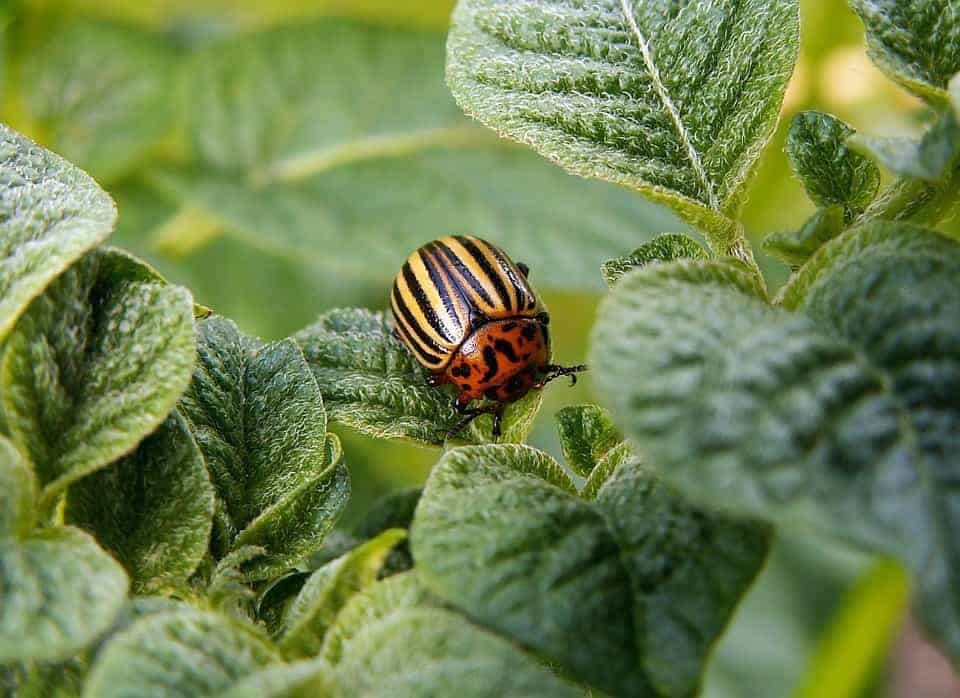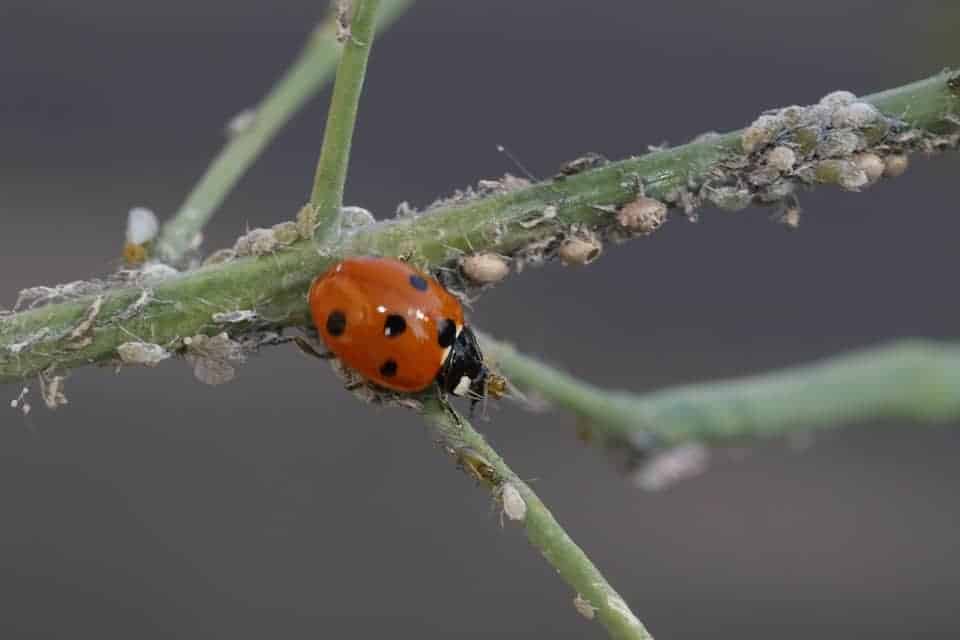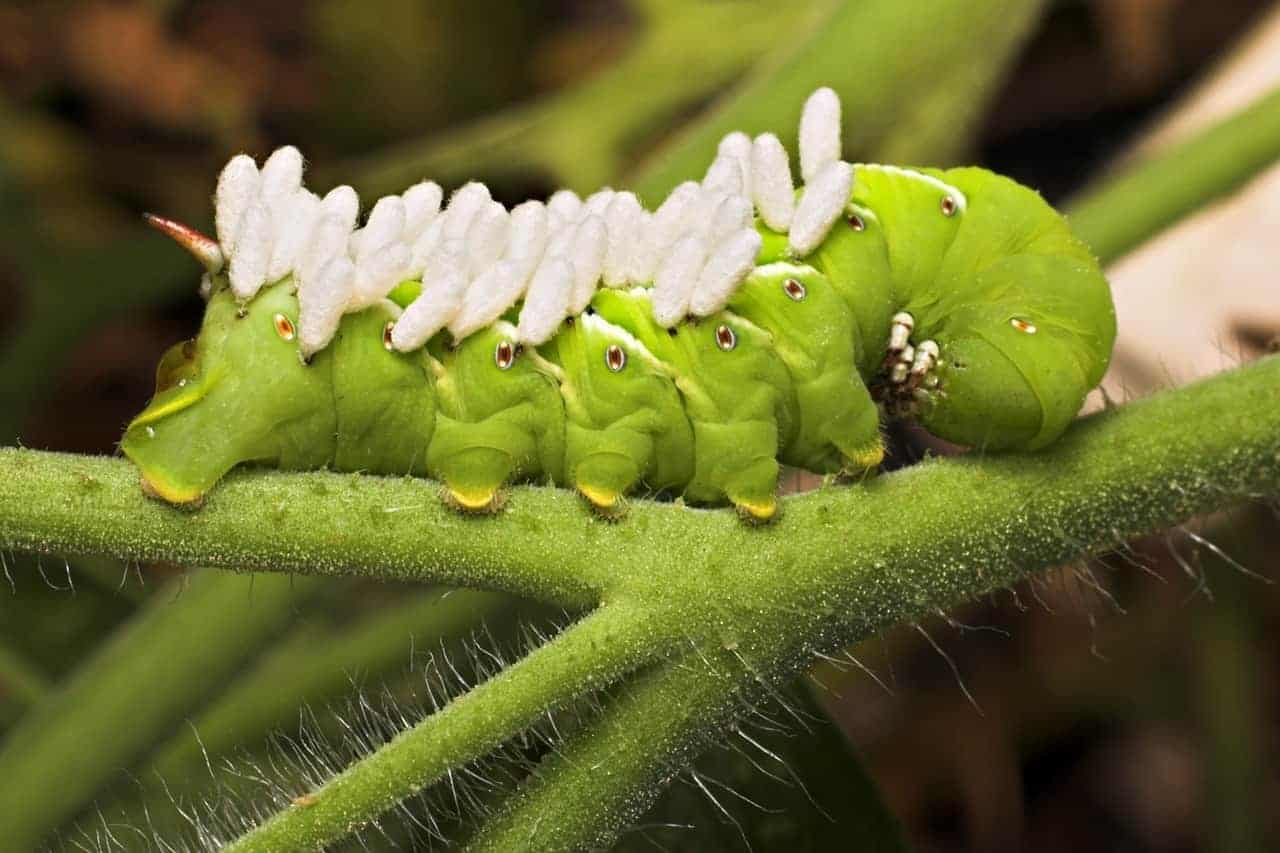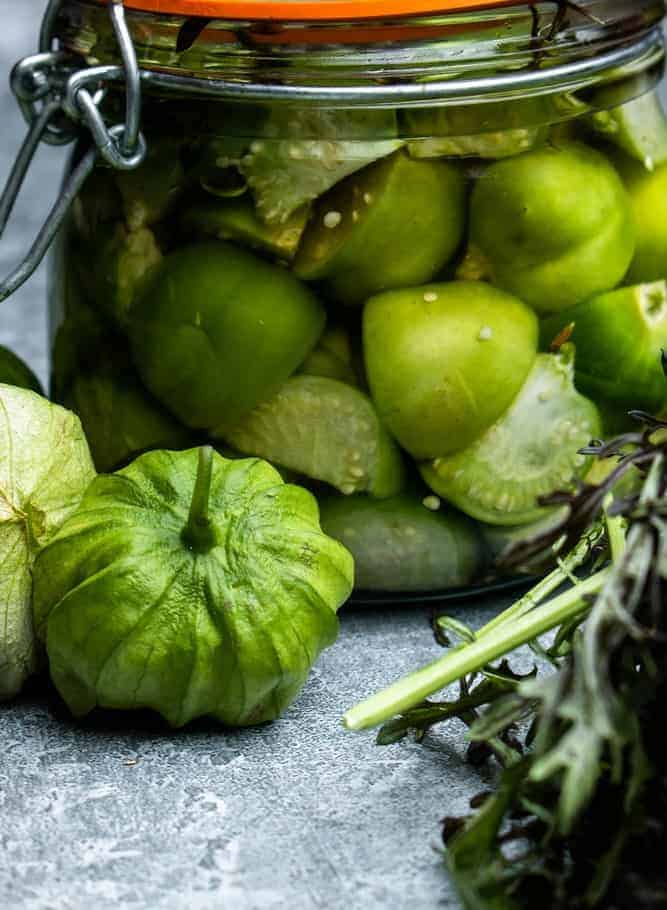Tomatillos are fairly resilient plants, and are not as sensitive to pests and disease compared to other vegetables. However, tomatillos that are stressed, unhealthy, or are growing in very wet conditions are more susceptible to both disease and pests.
Always make sure your tomatillos are not crowded and have plenty of air flow, are well-watered, and have enough nutrients to grow healthy and strong. Even then, you may have some problems, but your tomatillo plants will be much more resilient and survive much longer. A relevant example from my garden this year is a zucchini plant that is completely full of powdery mildew but still somehow producing lots of zucchinis.
If you can’t identify the cause of a problem or you’re having a particularly bad infestation, you can (and should) consult your local agricultural extension – you can search for your local extension office here. Extensions are an incredible resource and are staffed with experts who are knowledgeable about growing fruits and vegetables in your area.
On this page:
Tomatillo Plant Pests
Tomatillos are in the nightshade (Solanaceae) family, which includes tomatoes, peppers, eggplants, groundcherries, and potatoes. So, pests that affect other nightshades can also affect tomatillos. However, there are some that are more strongly attracted to tomatillos, or can be very destructive.
Potato Beetles
Tomatillo plants can easily become overwhelmed with potato beetles. These insects are named because they prefer targeting potato plants, but tomatillos are also their favorite.
Potato beetles are around 1/4 inch long, are orange to yellow, and have stripes running lengthwise. All potato beetles can eat tomatillos, but the three-lined potato beetle particularly loves them.
Note: Three-lined potato beetles look very similar to striped cucumber beetles, but the latter are more yellow and will swarm your cucumber and squash plants instead.
Three-lined potato beetles lay their orange eggs in clusters along the veins on the underside of leaves. Both the hatched larvae and the adult potato beetles eat the leaves, and there can be more than one generation of potato beetles in a year.
How to control potato beetles on tomatillos
Non-insecticide interventions work best early in the season, mainly insect netting or row covers to keep potato beetles off the tomatillos. If your infestation is minor, you can also pick off individual beetles.

Once you have an infestation, there are organic insecticides that work with potato beetles. Insecticidal soaps with pyrethrins are effective against eggs, larvae, and adult potato beetles. Pyrethrins are naturally derived from a species of chrysanthemum flower and work by attacking the nervous system of insects.
Because pyrethrins work on all insects, either avoid spraying the flowers or spray in the evenings when pollinators are less active. Pyrethrins will rapidly break down after a 1 to 2 days, so repeated applications are necessary.
Another organic option is neem oil. Neem oil is extracted from the neem plant and when diluted in water is a potent insecticide. Neem oil works more slowly than pyrethrins – the way it works is by disrupting the hormones in the insects, making them feed less and gradually die off. Since neem oil breaks down more slowly, it requires less frequent applications. It can also be used as a preventative if you know you will be getting potato beetles.
Always apply pyrethrins and neem oil to both the top and underside of the leaves, as the eggs and larvae will be under the leaves. Always test any plant spray (insecticide, foliar feed fertilizer, etc.) on a small area of a plant and check it over the next few days to see if your plant will tolerate it. Follow the instructions of whatever brand you’re using, as they can come in different concentrations and may require further dilution before spraying.
Another organic option is to use diatomaceous earth. This is a white powder made from crushed diatoms (algae with silica in their cell walls). It is mainly used to control adult potato beetles. Apply a dusting of diatomaceous earth over your plant and on the leaves, but avoid sprinkling on the flowers to avoid harming beneficial pollinators. It is non-toxic and feels soft and fluffy in your hands – but don’t breathe in the dust. Microscopically, it’s like finely ground glass powder, and when the beetles walk over it, it sticks to their bodies and acts as an abrasive, wearing out the protecting outer coating of their bodies. The result is that the beetles very quickly dehydrate and die. Diatomaceous earth needs to be reapplied after rain.
Flea Beetles
If you’ve ever noticed tiny holes on the leaves of your tomatillos, like someone was hunting bugs with the world’s tiniest shotgun, then it’s possible you have flea beetles. Flea beetles are very small, shiny, black beetles that quickly jump around if disturbed (hence the name flea beetles). They feed on the leaves of many plants, but in my experience, they love tomatillos, groundcherries, and tomatoes.
Flea beetles lay their eggs at the base of the plant, and the larvae go down into the soil to feed on the roots while the adults eat the leaves.
Damage is usually minor and cosmetic, mainly affecting the lower leaves of mature tomatillo plants, but can devastate seedlings and smaller bush-type tomatillo varieties.
How to control flea beetles on tomatillos
Flea beetles are often not a serious problem for mature tomatillo plants, but you can control flea beetles in mostly the same way you control three-lined potato beetles. Use physical preventatives like small-meshed insect netting before flea beetles appear. Apply insecticidal soap with pyrethrins or diluted neem oil to the top and underside of the leaves to control for adults. Spraying at the base of the plant will help control larvae and eggs. If using diatomaceous earth, dust it over the leaves and branches, while avoiding the flowers.
Aphids
Aphids are small, often green insects that suck the sap out of your plants, and can be found on the stems, branches, and base of the leaves. They affect many types of plants, including tomatillos. Small numbers of aphids can often be ignored or dealt with easily, but large infestations can severely weaken or even kill tomatillos.
Occasionally, you may find ants walking along the plants with your aphids. Ants can enter a mutually beneficial relationship with aphids, protecting the aphids from predators while harvesting the sweet sap from the aphids. Aphids can blend in and be hard to find, so if you see ants on your tomatillos, check closely for aphids.
How to control aphids on tomatillos

Aphids are one of the easiest pests to control, but can be tiresome to deal with when serious infestations occur. One physical control measure is to spray off the aphids with a strong jet of water. The aphids will wash off, and as slow-moving crawlers, they will often not be able to find their way back to the plant and die.
Another physical method of controlling aphids involves smearing petroleum jelly along the base of the stem. This reduces (but won’t entirely prevent) the ability of aphids and their ant protectors from
You can also control aphids with insecticidal soap with pyrethrins or you can apply neem oil. Some gardeners even just use a mixture of water, oil, and a few drops of dish soap to smother the aphids. They are soft-bodied insects, so diatomaceous earth doesn’t work as well on aphids.
Leaf Miners
If you find your tomatillo leaves have squiggly pale lines, it is likely they have leaf miners. Leaf miners are a broad category of insects that affect different plants, and are called leaf miners because the larvae actually burrow inside the leaf, eating it from inside.
Because leaf miners are inside the leaves, they are mostly protected from predators. Unfortunately, that also means they are less susceptible to organic (or inorganic) insecticides. Fortunately, leaf miners are often not a serious pest for tomatillos, unless you have a large infestation or they start attacking small, young plants.
Leaf miners lay their eggs in clusters on the underside of the leaves. Removing the eggs and checking your plants regularly is often enough to control leaf miners.
How to control leaf miners on tomatillos
Once a leaf miner is present, the best way to deal with them is by removing the affected leaves or by squeezing the affected portion of the leaves between your fingers to kill the little larva inside.
If you notice you have leaf miners, you should also check the underside of the leaves for clusters of tiny white eggs. Remove them by hand before the eggs hatch to prevent leaf miners.
Leaf miner larvae are protected inside the leaves from insecticides, but both neem oil and pyrethrins are effective on insect eggs. Applying either to the underside of leaves can help control leaf miners if they are a persistent problem.
Hornworms

Hornworms are one of the less common tomatillo pests, but are the most devastating of all. They are the caterpillars of the hawkmoth. While preferring other nightshades, like tobacco and tomato plants, they can affect all nightshades, including tomatillos.
Possible hornworm damage is identified by defoliation (leaves completely eaten) and dark green caterpillar poop that’s fallen on the leaves and branches.
These caterpillars are green and very quickly grow to several inches. Full-sized hornworms can quickly defoliate an entire tomatillo plant in days.
How to control hornworms on tomatillos
Organic insecticides like pyrethrins and neem oil work on hornworms, but hornworms can be easily controlled by manually checking and picking them off your tomatillo plants.
If you have a difficult time finding hornworms that are blending in with your tomatillos, you can use a UV blacklight to search for hornworms after dark. They glow when exposed to UV light and can be easily removed from the plant.
Tomatillo Plant Diseases
Tomatillos are fairly disease resistant and unless you are growing in a very humid climate, you may go an entire season without any diseases. However, unhealthy tomatillo plants are more susceptible to disease, and they can still be infected by diseases that infect other nightshade plants.
Never compost diseased tomatillo plants, leaves, or fruits.
Blight, Early/Late
The same blight that infects tomatoes can also infect tomatillos. Blight is a fungal disease that is naturally found in the soil, but causes infection when exposed to tomatillo leaves.
Blight can be identified as gray, brown, or purple dead spots along your lower leaves, which gradually spread throughout your plant. Early blight affects tomatillos early in the season, while late blight affects them in late summer and fall.
Blight does not affect the size or quality of tomatillo fruit, but will weaken your plants and can eventually kill them, given enough time.
Controlling early and late blight
Once your tomatillo is infected with blight, there is not much you can do to stop it, but you can prevent or slow down the progression of blight to protect your yields. Wet conditions are ideal for blight infection, so don’t water your tomatillo plants from overhead – instead, water at the base of the plant and be careful not to splash soil onto the leaves.
Similarly, spacing your tomatillo plants more so they aren’t crowded can allow more air flow so leaves don’t stay wet after the rain or morning dew.
I also recommend pruning off the lower tomatillo leaves that are touching or near the surface of the soil. It’s just too easy for blight to spread from the ground to your tomatillos if the leaves are in constant contact with soil.
 Adding a layer of mulch underneath your tomatillos will also reduce blight spores splashing onto your leaves.
Adding a layer of mulch underneath your tomatillos will also reduce blight spores splashing onto your leaves.
Other preventive measures include using organic fungicidal treatments. One home remedy uses a dilute solution of 1 tablespoon of baking soda, 1 teaspoon of oil, and a few drops of soap in 1 gallon of water, sprayed on the leaves. The baking soda increases the pH on the surface of the leaves while the oil and soap help it stick. A higher pH inhibits the growth of fungi. This will need to be reapplied regularly to keep it effective. Always test any plant spray (fungicide, insecticide, foliar feed fertilizer, etc.) on a small area of a plant and check it over the next few days to see if your plant will tolerate it. If the tested leaves die from the baking soda solution, cut the amount to 1/2 tablespoon and test it again in another part of the plant.
You can also try to find organic fungicides. Copper-based fungicides can be quite effective, but there are concerns they may cause harm if consumed. Furthermore, if you are facing late blight, it often it isn’t worth using chemical fungicides unless you live somwhere with a long growing season and still expect much more tomatillo harvests.
Immediately remove any leaves with signs of blight. It’s not recommended to compost them. At the end of the season, you also shouldn’t compost your blight-infected tomatillo plants.
Lastly, you can find blight-resistant tomatillo varieties, which will naturally be able to fight off infection.
Anthracnose
Another fungal disease, anthracnose affects the leaves and stems, but on tomatillos is more often found on the tomatillo fruit itself. It’s characterized by small black and brown spots on the fruit with sunken or soft flesh around them. The spots continue to grow, and eventually cause the whole fruit to rot on the plant.
While potentially ruining your fruit, it doesn’t seem to kill the entire tomatillo plants. On the leaves and stems, it appears as small circular spots and dried sections of leaves, but is hard to identify as anthracnose because many things can cause those symptoms. However, if you look under the leaves that have these spots, you may find small light brown dots which are a hint that your tomatillos have anthracnose.
Controlling tomatillo anthracnose
Similar to blight, once you have anthracnose, there isn’t much to do to stop it, but you can use the same preventive and mitigation measures used to control blight.
Just as with early or late blight, anthracnose can usually be prevented by not watering overhead, keeping your tomatillos mulched, spacing them enough to allow adequate air flow, and pruning any leaves touching the soil. You can also use the baking soda solution described above to prevent or slow down the spread of anthracnose on your plants.
Any leaves that look like they have anthracnose should be removed, as well as any fruit. If anthracnose spots are not severe on your tomatillos, you can safely slice off the affected parts and eat the rest of the fruit.
Do not compose the leaves or dead tomatillo plants that have been infected with anthracnose.
Tobacco Mosaic Virus (TMV)
Tobacco Mosaic Virus is a plant virus that infects nightshades, especially tobacco. But tomatillo plants can sometimes get infected, especially if you have TMV in other parts of your garden.
The main symptoms of TMV are curled leaves with a mosaic pattern of yellow discoloration on the leaves between the leaf veins.
A related disease is called Tomato Mosaic Virus (ToMV) which has similar symptoms and should be treated similarly.
Controlling TMV in tomatillos
If you have identified that your tomatillos have TMV or ToMV, there is nothing you can do to stop it. TMV-infected plants must be thrown out or destroyed, and never composted. The virus can easily spread to other tomatillos or their nightshade relatives by touching the plants, so always wash your hands after handling infected plants.
If you’re a smoker, TMV can also be transmitted by handling cigarettes with tobacco that has been infected, so you should also wash your hands after smoking before handling the plants.
If you’ve confirmed that your tomatillos have been infected with TMV, it’s advised to not plant any nightshade (tomato, potato, pepper, groundcherry, tomatillo, eggplant) in the same bed for at least two years.
Other Tomatillo Problems
Stunted Growth
There are several reasons why your tomatillo plants are not growing. If you’ve just recently transplanted them, it’s possible that they are undergoing transplant shock, and will eventually start growing again.
If the roots have been damaged during transplanting, this could set back your tomatillo plants by a few weeks, but eventually they will recover.
Cold temperatures can stunt the growth of tomatillo seedlings. It’s recommended to transplant tomatillos after night temperatures stay above 50°F (10°C). As a rule of thumb, you can transplant your tomatillos the same time or after your tomatoes.
Blossom End Rot
Tomatillos which have a rotten part on the bottom (blossom end) of the fruit can be mistaken for a disease, but is often just blossom end rot.
The rest of the tomatillo is safe to eat; just cut off and discard the rotten bottom of the fruit.
Blossom end rot is caused either directly or indirectly by not enough calcium in the plant, which is important for fruit development. Even if your soil has enough calcium (which most soils do), this can still happen when the soil dries out too much, because plants cannot absorb nutrients from dry soil.
Blossom end rot can happen to many fruiting vegetables, but is more common when growing in containers. Containers, especially smaller ones, can dry out very easily, reducing calcium uptake and increasing your chance of blossom end rot.
Ensure your tomatillos don’t dry out by watering regularly (especially when growing in containers) and using mulch to decrease evaporation.
If your tomatillos are still experiencing blossom end rot, you may actually have a calcium deficiency in the soil. There are calcium fertilizers on the market you can add to your soil, but crushed egg shell is a tried-and-true, organic slow-release source of calcium.
